|
Friday, May 30
- Breakfast: French bistro breakfast
- Breakfast: chorizo and egg burrito
- Grilled chicken quesadilla
- Smart cuisine: herb and lemon fish
- Vegetarian eggplant lasagna
- Cuban panino
- Breakfast-for-lunch omelet bar
- New England clam chowder
- Texas-style chili
- Assorted pizza by the slice
Wilson Hall Cafe menu
|
|
Friday, May 30
Dinner
- Melon and prosciutto
- Medallions of beef with madeira mushroom sauce
- Potatoes gratin
- Asparagus
- Chocolate souffle
Wednesday, June 4
Lunch
Menu unavailable
Chez Leon menu
Call x3524 to make your reservation.
|
|
P5 community presentation - Monday in Ramsey Auditorium
P5 Chair Steve Ritz will present and discuss the P5 report via teleconference on Monday, June 2, at 11:30 a.m. Central time. Scientists at Fermilab who wish to listen are invited to join the presentation from Ramsey Auditorium.
|
What is a jet?
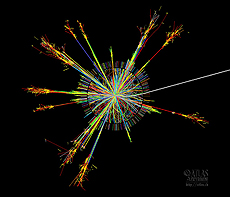 |
| In particle collisions like the one shown above, it is common for debris to be grouped into clumps known as jets rather than uniformly distributed in a circle. This event has about 10 jets, but most have only two or three. Image courtesy of ATLAS
|
In these articles, I often get stuck when I need to describe jets. Jets are complicated yet ubiquitous in particle physics — they're hard to avoid and hard to explain. In this article, I intend to give jets the space they deserve.
Whenever a single quark or gluon flies off on its own, it pulls new particles out of the vacuum and becomes a cloud of particles, flying in roughly the same direction. This is a jet. If physicists want to know how many quarks or gluons were emitted by an interaction, they have to disentangle the (sometimes overlapping) jets.
This phenomenon is unlike any other in particle physics. There are other processes that create particle-antiparticle pairs, but free quarks spontaneously generate more quarks until they are all are bound, either in pairs or triples. Isolated quarks cannot exist because the force between them doesn't fall off to zero with distance. Gravity, electric forces and the weak force all become negligible as objects separate, but the strong force, which governs the behavior of quarks, increases as quarks separate, leveling off to a constant — approximately 14 tons.
When a quark is far enough from its neighbors, the energy becomes large enough to become the mass of a new quark-antiquark pair. (Distance times force is energy, and energy can be converted into mass.) This is why an isolated quark doesn't stay isolated: It costs less energy to create more quarks than to be alone. For a highly energetic quark or gluon flying away from a collision, this process happens several times, resulting in a jet.
Although jets are interesting on their own, they're present in any interaction that produces quarks or gluons. Often, they act as a smokescreen, hiding information about the primary interaction. For instance, more than half of Higgs bosons decay to a b quark and a b antiquark, but they appear in a particle detector as dozens of particles in two rough bundles. It's hard to tell exactly which particles came from each quark and which are from other debris. This ambiguity is a source of uncertainty in the energy of the original b quarks — so much so that the Higgs mass peak has never been observed in this decay mode, despite it being the most frequent.
To combat the uncertainties due to jets, physicists have developed sophisticated jet finding algorithms. These algorithms are related to clustering, a machine learning technique that lets computers discover patterns on their own, but jet finders are more highly specialized. The latest generation of algorithms peers inside the jet and identifies individual particles (particle flow algorithms) and even jets within jets (jet substructure algorithms). It is now possible to do precise experiments with jets, despite their apparent messiness.
—Jim Pivarski
Want a phrase defined? Have a question? Email today@fnal.gov.
|
In the garden
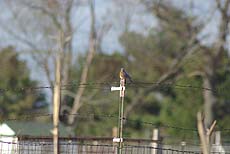 |
| A bluebird enjoys the surroundings of the Fermilab Garden. Photo: Barb Kristen, PPD
|
|
FIFE Offline Computing Workshop, June 16-17; new FIFE documentation available
There are many challenges in offline computing and many ways to accomplish a particular task. To help experiments at Fermilab think through the options, the Scientific Computing Division has prepared documentation that summarizes the tools offered within FIFE, the FabrIc for Frontier Experiments.
Understanding the available options will help save time, effort and frustration in developing offline computing environment solutions for Fermilab experiments.
To provide assistance for experimenters using these tools, the FIFE Offline Computing Workshop will take place in the CDF Big Room at Fermilab on Monday, June 16, and Tuesday, June 17. Registration is free. Please visit our website to reserve your spot and view the agenda. Email the workshop organizers Margaret Votava or Mike Kirby with questions. We look forward to seeing you there!
|
Nine scientists are awarded Kavli prizes
From The New York Times, May 29, 2014
Beaming in from Oslo via the web, officials of the Norwegian Academy of Science and Letters invaded the World Science Festival in New York on Thursday to announce that nine scientists had won this year's Kavli prizes. The winners will split million-dollar prizes awarded in three categories: astrophysics, nanoscience and neuroscience.
The prize is named for Fred Kavli, the Norwegian-born inventor, businessman and philanthropist, who died last year. He spent the last decade of his life handing out money to establish Kavli research institutes at universities around the world and the prizes, which are awarded every two years and which he hoped would someday rival the Nobels.
The astrophysics award this year goes to the founders of the theory known as inflation, which posits that the Big Bang began with an extraordinary ballooning of space-time faster than the speed of light. They are Alan H. Guth of the Massachusetts Institute of Technology, Andrei D. Linde of Stanford and Alexei A. Starobinsky of the Landau Institute for Theoretical Physics in Moscow, Russia.
Read more
|
|
The Dark Energy Survey looks at massive galaxy clusters - and finds filaments
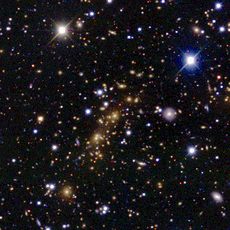 |
| With data from the new DECam imager, the Dark Energy Survey provides additional clues that galaxy clusters are not isolated objects on the sky but are connected with the cosmic web via filaments. Shown here is the famous Bullet cluster. Image: Dark Energy Survey
|
Galaxy clusters — accumulations of hundreds of galaxies — are said to be the largest gravitationally bound structures in the universe. While this statement is correct as such, it easily conveys an incorrect picture: that of clusters as static, isolated spheres that have swallowed every galaxy within reach at some time in the cosmic past. Nothing could be further from reality.
Galaxy clusters are not isolated but dynamic environments that actively accrete material from their surroundings. The preferred mode of accretion proceeds along so-called filaments, the connecting links between the central hubs of the cosmic web. The existence of filaments is a prediction of the cold dark matter model we use to describe the formation of structures in the universe, revealed in large cosmological simulations and spectroscopic surveys.
The new Dark Energy Camera was built by the 300-member Dark Energy Survey (DES) collaboration to carry out a five-year survey to probe the origin of cosmic acceleration. The camera is mounted on the Blanco 4-meter telescope at the Cerro Tololo Inter-American Observatory in Chile and saw first light in September 2012.
Shortly after the camera was commissioned, we proposed a program to target several massive galaxy clusters as part of a process called science verification, a rigorous test of the new instrument. The prospects for this project were mixed. After the overhaul of the telescope control system and with the new camera, nobody could guarantee that the images we were going to obtain would have the necessary quality for accurate studies of these clusters. But if it worked, we could exploit DECam's massive field of view of more than 3 square degrees (roughly 15 times the area of the full moon) to study not only the clusters themselves, but also the environments from which they accrete.
It worked. Over the course of 18 months, I led a team that ultimately involved more than 90 DES scientists from 37 institutions worldwide. In our recently submitted paper, the first based upon DES data, we demonstrated that the new camera and revamped telescope worked together as expected. This data and our careful analysis allowed us to determine the distributions of so-called red-sequence galaxies, whose red color is a reliable tracer of the dynamical processes in clusters. Furthermore, we exploited an effect called gravitational lensing to infer the mass distributions of these clusters, an analysis with exceptionally stringent requirements on image quality.
Everything lines up. The visible orientation of the brightest cluster galaxies sitting at the cluster centers; the mass distribution tracing hundreds of cluster galaxies (shown in the image below); the large-scale distribution of red-sequence galaxies far beyond the gravitational reach of the actual clusters: All these probes show that clusters are indeed interwoven with the cosmic web, the structure of which DES will reveal in unprecedented detail.
—Peter Melchior, Ohio State University
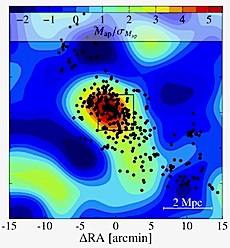 |
| This plot shows the mass distribution from weak-lensing measurements (contours) and red-sequence galaxies (black dots) of the galaxy cluster RXC J2248.7-4431 at redshift z=0.348.
The red-sequence galaxy distribution extends substantially farther out, reaching a total length of approximately 1 degree, or twice the diameter of the full moon.
|
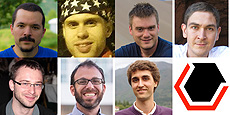 |
| These scientists are the primary authors of this work. Top row, from left: Peter Melchior (Ohio State), Eric Suchyta (Ohio State), Eric Huff (Ohio State), Michael Hirsch (U College London). Bottom row, from left: Tomasz Kacprzak (Manchester), Eli Rykoff (SLAC), Daniel Gruen (University Observatory and MPE Munich).
|
|
Science Next Door June newsletter now online
The June edition of "Science Next Door," Fermilab's monthly community newsletter, is now available online. View it or subscribe to get the latest about the laboratory's public events, including tours, lectures, arts events and volunteer opportunities.
|
|